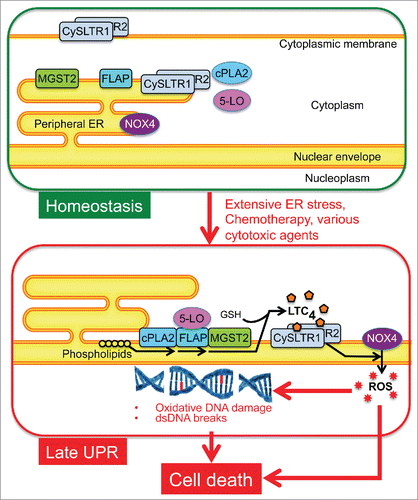Endoplasmic reticulum (ER) stress and major chemotherapeutic agents damage DNA by generating reactive oxygen species (ROS). We recently reported that ER stress and major chemotherapeutic agents induce leukotriene C4 (LTC4) biosynthesis in cells of non-haematopoietic lineage.Citation1 ER stress or chemotherapy activate LTC4 biosynthetic machinery by assembly at the nuclear envelope of microsomal glutathione-S-transferase 2 (MGST2), 5-lipoxygenase (5-LO), 5-lipoxygenase-activating protein (FLAP) and cytoplasmic phospholipase A2 (cPLA2). ER stress and chemotherapy also trigger nuclear translocation of the two LTC4 receptors, CysLTR1 & CysLTR2. Acting in an intracrine manner, LTC4 then elicits nuclear translocation of NADPH oxidase 4 (NOX4), resulting in nuclear ROS accumulation, oxidative DNA damage and dsDNA breaks. MGST2 deficiency, RNAi and LTC4 receptor antagonists abolished ER stress- and chemotherapy-induced ROS accumulation and DNA damage in vitro and in mouse kidneys. Notably, acting as a CysLTR1 antagonist, the approved asthma drug pranlukast abolished doxorubicin-triggered DNA damage. Cell death and mouse morbidity were also significantly attenuated (). Hence, we concluded that MGST2-generated LTC4 is the major mediator of ER stress- and chemotherapy-triggered oxidative stress and oxidative DNA damage, thereby augmenting cell death. Tumor cells of haematopoietic origin do not express MGST2. Indeed, they remained sensitive to chemotherapy in the presence of LTC4 inhibitors. We therefore propose that LTC4 inhibitors, commonly used for the treatment of asthma, may alleviate chemotherapy-associated morbidities when used in hematologic malignancies. In addition, our findings provide the possible mechanism by which these asthma drugs attenuated the neurotoxicity of amyloid β peptide – the suspected trigger of Alzheimer's disease, damage to heart myocytes by hypoxia-reperfusion as happens in myocardial infraction and gentamycin-triggered kidney damage.Citation2-4 NOX4 has also been implicated in these and additional major human pathologies, including metabolic diseases, neurodegeneration and osteoporosis.Citation5-7 Therefore, inhibition of its activation by LTC4 receptor antagonists, already serving as approved asthma drugs, may have broad clinical significance.
Abbreviations
| cPLA2 | = | cytoplasmic phospholipase A2 |
| CysLTR1 & CysLTR2 | = | the 2 LTC4 receptors |
| ER | = | endoplasmic reticulum |
| FLAP | = | 5-LO activating protein |
| 5-LO | = | 5-lipoxygenase |
| LTC4 | = | leukotriene C4 |
| MGST2 | = | microsomal glutathione-S-transferase 2 |
| NOX4 | = | NADPH oxidase 4 |
| ROS | = | reactive oxygen species |
References
- Dvash E, et al. Nat Commun 2015; 6:10112; PMID:26656251; http://dx.doi.org/10.1038/ncomms10112
- Tang S-S, et al. Int J Neuropsychopharmacol 2014; 17:581-92; PMID:24229499; http://dx.doi.org/10.1017/S1461145713001314
- Ni NC, et al. J Pharmacol Exp Ther 2011; 339:768-78; PMID:21903747; http://dx.doi.org/10.1124/jpet.111.186031
- Otunctemur A, et al. Renal Failure 2013; 35:403-10; PMID:23342977; http://dx.doi.org/10.3109/0886022X.2012.761040
- Montezano AC, et al. Ann Med 2012; 44 Suppl 1:S2-16; PMID:22713144; http://dx.doi.org/10.3109/07853890.2011.653393
- Radermacher KA, et al. Antioxid Redox Signal 2013; 18:1418-27; PMID:22937798; http://dx.doi.org/10.1089/ars.2012.4797
- Harrison C. Nat Rev Drug Discov 2013; 12:904; PMID:24287775; http://dx.doi.org/10.1038/nrd4182

